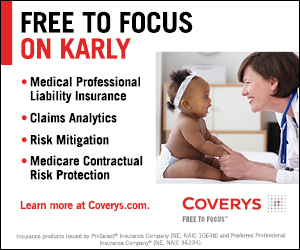Accelerating scientific advancement.
Cutting-edge research.
Unprecedented numbers of treatment options.
With all these high-tech innovations at a physician’s disposal in 2021—and with the threat of pandemic still lingering—stopping to focus on the competitiveness of an individual practice may strike providers as a low priority. But changing federal requirements, coupled with COVID-induced changes in how business gets done, is raising the bar. And fast.
Today, Michigan physicians are working harder than ever to not only protect their patients’ health, but also to quickly adopt and assimilate new technologies into their practices. A new federal ‘open notes’ rule is now in effect, and practices are still thinking about ways in which the telehealth tools they adopted during COVID can be used over the long term.
Providers that deploy these new technologies effectively will quickly become leaders in their markets. To keep pace, it’s important to ensure all new tools are used seamlessly in ways that enhance patient experiences. For physicians, that means understanding a practice’s competitive assets and liabilities as never before, so they can put their best feet forward.

It Begins with the Basics
According to the Henry J. Kaiser Family Foundation, there are nearly 41,000 physicians practicing in Michigan. Nearly half (46 percent) of them work in primary care, which means the competition for patients—particularly in the state’s urban areas—can be stiff.
The first step to addressing competitive forces is simple: make a list.
Nick Hernandez, MBA, FACHE, is CEO and founder of ABISA, a consultancy that helps devise and implement strategies that allow practices to remain competitive and solvent. He suggests compiling a list of practice competitors as a critical first step.
“Most of the time, such a list is comprised of who your practice considers to be its chief competitors. However, there may be other health care organizations that indirectly compete with yours, perhaps ones outside of your catchment area that offer services such as telemedicine or niche treatment modalities that are aiming for the same patients,” Hernandez writes. “You will also want to include information on health care entities that may be entering your market in the coming year. Once you have compiled the list, you can highlight those practices that will be the greatest challenge.”
Other competitive challenges may be less easy to pin down but are equally important. Online-only telehealth providers (the old “doc in a box” model that existed a decade before COVID) and self-diagnosing patients also pose competitive issues for physicians. According to Consumer Reports, 65 percent of Americans rely upon Dr. Google for information about their symptoms, rather than pursuing the care options they may truly need. These are concerning trends for physicians who are trying to create patient-centered medical homes for their patients.
Even though the use of these options may be difficult to quantify, it does provide valuable hidden feedback about what many patients are seeking—convenience. It is this expectation that is, in part, driving the expansion of open notes and telehealth in today’s marketplace.
Hernandez suggests incorporating this type of feedback into a competitive market analysis.
“[It’s important for physicians to] compile an objective list of competitor strengths and weaknesses,” he writes. “Try to see the competition’s practice as though you were them. What makes their practice so great? If they are growing rapidly, what is it about their practice that’s promoting that growth?”
Finally, Hernandez says it is important to look to the future by analyzing practice demographics, as well.
“Is [your market] growing? If so, then there are likely quite a few patients left to go around. If on the other hand the market is flat, then the competition for patients is likely to be fierce. Your practice will find itself scrambling to win market share,” Hernandez writes. “The outlook portion of your analysis may seem like forecasting, but it is really a measure of trends. By the time you have done most of your research, you will have enough information to determine what the outlook really is.”
Where the Rubber Meets the Road: The Online Review
Once a practice’s competition has been evaluated, it’s time to do the trickier work of self-assessment. This is a challenging task, as it requires a level of objective analysis that can feel difficult to physicians and their staffs. Internal bias toward competitors and feelings of defensiveness can cloud thinking and result in an analysis that is skewed and, ultimately, inaccurate and unhelpful.However a physician chooses to rip off this particular band-aid, it’s not easy work. Many practices begin their analysis in the same place many of today’s patients do: they consult Google. They seek out star ratings and online feedback, searching for trends and comments that can help them understand their own strengths and weaknesses more fully.
“This is tough, because many physicians find themselves frustrated about what people post,” says Dara Barrera, MSMS Manager, Practice Management & Health Information Technology. “It’s never about the quality of the medical care they’ve received, it’s usually about the wait time or the horrible receptionist. That’s really frustrating and is a major reason why physicians tend to put little stock in those reviews.”
Those reviews matter, however. A 2020 survey conducted by Software Advice found that 90 percent of patients use online reviews to evaluate physicians. For 71 percent of patients, this is the first exposure they have to their physician’s practice. This survey also found:
- Forty-three percent of respondents said they were willing to go out of their insurance network to consult with a highly-reviewed provider. This underscores the importance of ensuring strong feedback from satisfied patients.
- Fewer than 10 percent of reviews are considered negative. This means the majority of reviews should be either positive or neutral, and therefore much easier to address.
- Two-thirds of survey respondents say it is helpful when providers respond publicly—and appropriately—to online reviews.
“There are things physicians can do to improve their star ratings, such as registering with review sites and keeping their profiles updated,” Barrera says. “The benefits of a strong web presence can be huge.”
Barrera agrees with expert recommendations that suggest designating a practice team member to help monitor, support and advance a strong online presence. She also points to strong marketing tools that are specifically designed for health care providers.
“There are customer relationship management software packages that help practices manage their interactions with patients,” Barrera says. “Many of these packages support event-based communication features that automatically send out emails asking for reviews after a visit or other interaction. This can support the number of positive reviews a practice receives and help make its website more visible to popular search engines.”
Taking It to the Next Level: Social Media
Nikki O’Meara, Director of Digital Marketing for Lansing-based Resch Strategies, says social media also can be a positive asset for physicians.
“I have seen doctors on Facebook, Instagram, TikTok—you name it. But knowing how to move forward is really dependent upon the target audience, the goals of the physician practice, and the information to be shared,” O’Meara says. “If a physician is starting from scratch and simply wants a social presence, then certainly a Facebook page is a great place to start. I say page verses a simple account, because the physician(s) must act as the face of the practice and provide resources and guidance to their patients and the community at large.”
Physicians also could consider using LinkedIn to communicate with their peers, according to O’Meara.
“Depending on the area of specialization, LinkedIn can serve as a great way to share the latest research and advancements within a practice, which could translate into primary care referrals,” O’Meara says. “Twitter offers the same opportunity but should be used with caution. It is the most volatile of all social platforms, as issues tend to escalate quickly and get out of hand.”
Barrera and O’Meara agree that market position and target audience should drive any effective social media and web-based strategy.
“Really, it comes down to how each platform is used,” O’Meara says. “As long as the physician has a plan and strategy in place for their social presence, it shouldn’t matter which platform is chosen to tell the story of his or her practice and its work.”
The Importance of a Strong Patient Portal
Many Michigan physicians have made effective use of web-based portals and apps as tools for communicating information with patients. And thanks to the “Information Blocking” rule of the 21st Century Cures Act, adopted in 2016, certain categories of clinical notes must be made immediately available to patients, which makes electronic portals even more essential for physician practices.
“While this is a requirement for providers, it also becomes a competitive asset,” Barrera says. “We know patients prize this information highly, so getting out in front with effective, easy-to-use tools that add convenience to their lives is going to be tremendously helpful.”
A large-scale 2019 survey of patients showed about two-thirds believed they had benefited from reading the notes in their electronic health records (EHRs). According to a study in the Journal of Medical Internet Research, these patients said the notes helped them take better care of their health, remember their care plans, feel in control, and be better prepared for their office visits.
“So now we have this requirement, which can feel challenging at first,” Barrera says. “However, in the long run, it becomes a support for positive patient outcomes and a strategic support for a more comprehensive online strategy. A well-informed, happy, healthy patient is also going to be a patient that rates their care highly and gives high marks to the provider that’s involved.”
Barrera points to other web-based strategies for making patients’ lives easier, and says it is possible for physicians to evolve in remarkable ways.
“We’re now seeing online scheduling, tools for online form submission by patients, telehealth and other leading-edge strategies for improving the patient experience,” Barrera says. “There are many secure tools available for use by physician practices, and it’s a sure bet Michigan patients are using many of them already. That means these technologies must factor into any meaningful discussion about practice competitiveness.”
Of course, the effective implementation of open notes remains relatively new ground for many physicians to cover.
“We are working with our member providers to help ensure their notes are clear, so patients can understand what they are reading,” Barrera says. “Jargon, acronyms, and other terms that could be misinterpreted need to be swapped out in favor of more easily understandable language.”
According to the American Medical Association, physicians also must learn to effectively document challenging issues, such as obesity, mental health, substance-use disorder, physical abuse, driving privileges and suspicions about life-threatening illnesses.
“I would recommend physicians work to make their patient portals and open notes as easy as possible for their patients,” O’Meara says. “This is about more than simply building the structure, it’s also about ensuring people understand how to use it and appreciate the value it adds to their care.”
O’Meara suggests personal contact with patients through email, personal correspondence, and office conversations, if necessary.
“Consider an FAQ document for patients that seem less tech-savvy and be sure to provide telephone support for people with questions,” she says. “If your practice is on social media or issues a periodic newsletter for its patients, these are great places to highlight the advancements you’re making. And, of course, your website should include resources for navigating through the EHR portal effectively.”
Telehealth as a Competitive Advantage
Enhancing patient care and convenience—and a provider’s market position—is part of the goal of a well-deployed telehealth strategy. What began as a narrowly-adopted innovation has become far more commonly utilized, thanks to a series of policy changes made during the COVID-19 pandemic last year. What happens after the pandemic is behind us, however, remains to be seen.
“In order for telehealth to be a lasting innovation, a few things need to happen in kind of a cascading way,” says Stacey Hettiger, MSMS Senior Director, Medical and Regulatory Policy. “First, patient and physician demand for this service option needs to remain robust. This will, we presume, lead to the second item, which is permanent policy change at the federal level. This, in turn, will result in a strong reimbursement structure that values telehealth and makes it viable for the long term.”
In particular, Hettiger notes that Medicare payment policies need to remain open to reimbursing a wider array of telehealth visits, and Health Insurance Portability and Accountability Act (HIPAA) restrictions need to be permanently made more telehealth-friendly. As a result of this federal leadership, private payers followed suit and opened up their own reimbursement models.
“I’m sure this is going to be a topic of discussion for some time to come,” Hettiger says. “Congress is going to want to review the data and work to ensure a balance between equitable compensation, service quality, and convenience. We may see telehealth extended in some areas where physical examinations aren’t required, while it may be more limited in others.”
There also may some differences in reimbursement rates, given the flawed assumption of many leaders that telehealth visits are less costly and/or time-intensive than face-to-face consultations.
“Physicians and other health care providers know otherwise,” Hettiger says. “Part of our job during the coming months will be to share our experiences and offer compelling competitive arguments for the permanent extension of telehealth for Michigan patients.”
Putting It All Together
The entrepreneurial side of health care practice is as much art as it is science. Knowing how to maximize and build upon a practice’s assets with fresh technologies and strategic supports requires an ear to the ground, as well as thoughtful, unbiased reflection and a nuanced understanding of patient experiences.
It also requires a keen eye for online innovation. The days of looking for a physician in the yellow pages have long passed by; it’s now incumbent upon providers to know their markets and attract the most robust digital footprints. Practices must deliver a patient experience that is simple, convenient and of the highest possible quality at all levels.
“A competent study of the competition can help reduce uncertainty and pave the way for strategic planning and business operations within your practice. Physician owners must be keenly aware of what competing practices are doing,” Hernandez writes. “Since managing a successful practice requires decision and action based on situational awareness, identification of your competition’s expectations and preparations is important.”
As providers continue to move through a period of unparalleled uncertainty and change, there’s no better time to regroup around patient experiences. After all, it’s the best possible way to become what all practices should strive to become: a patient-centered medical home.












